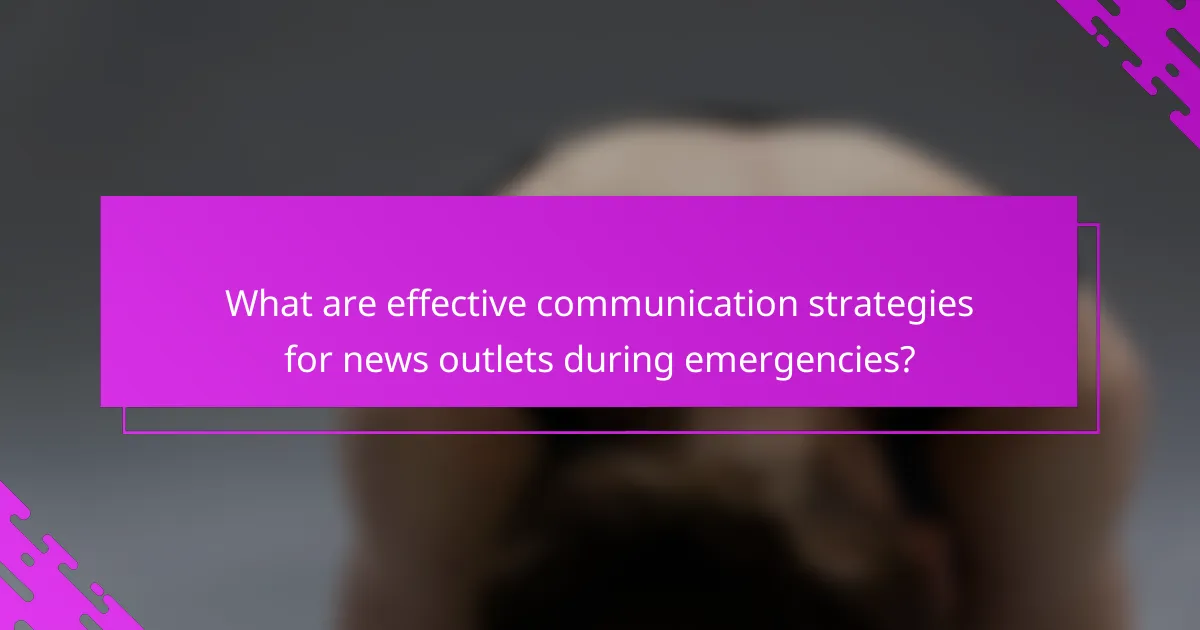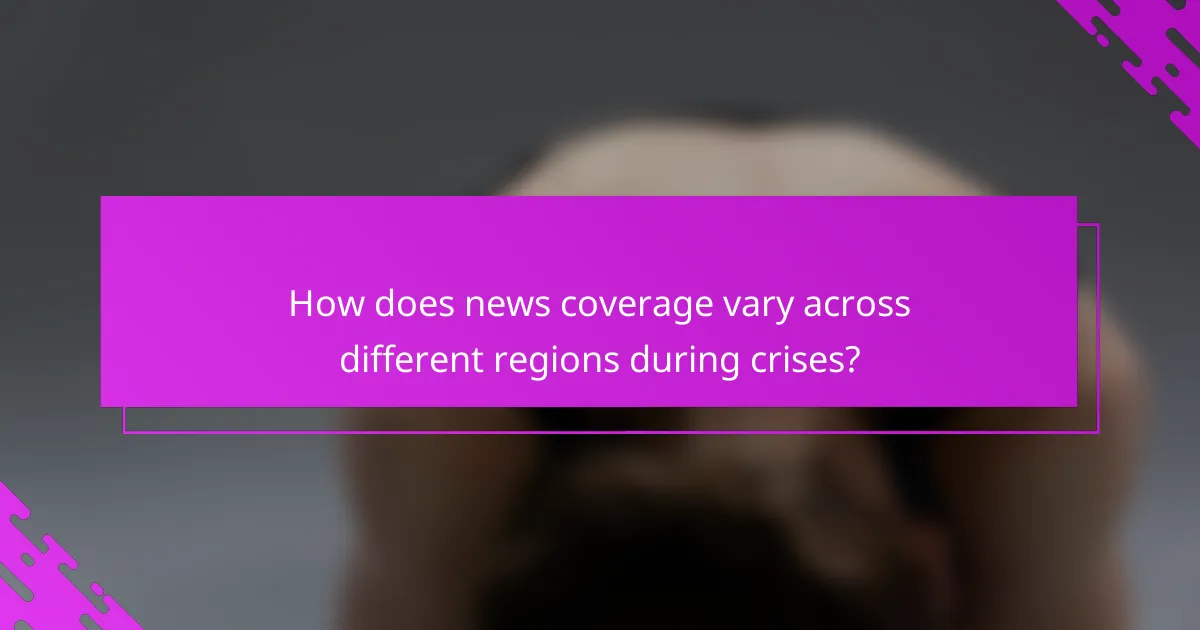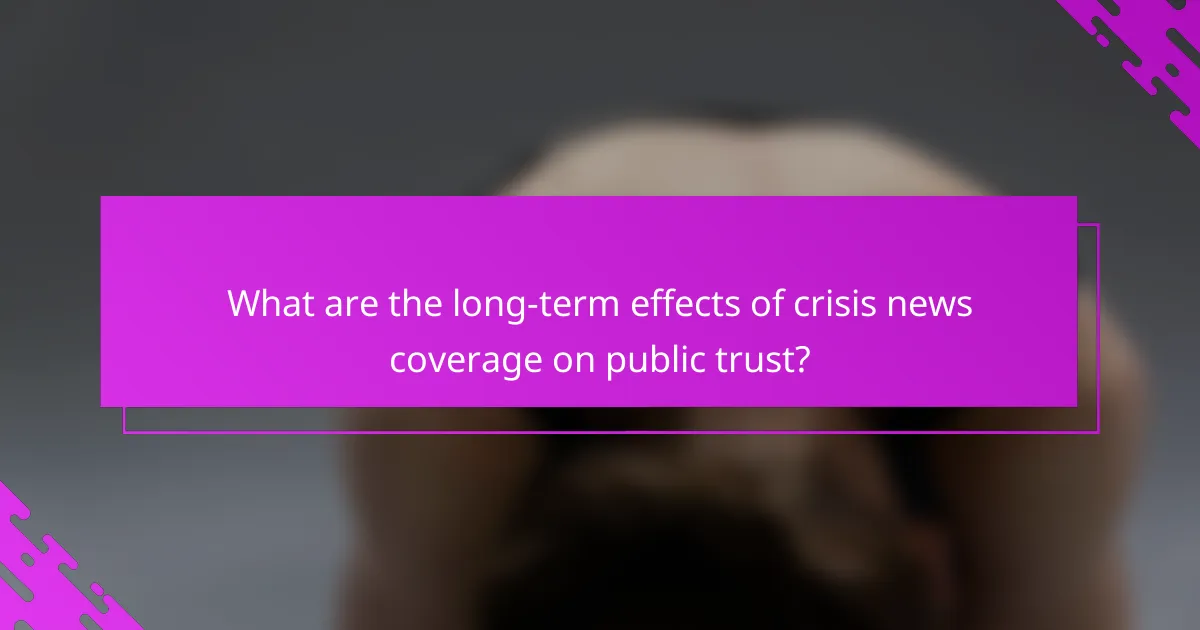News coverage is pivotal in shaping public response during crises and emergencies, as it informs individuals about the situation and influences their actions. Effective reporting enhances awareness and preparedness, while inadequate coverage can lead to increased anxiety and misinformation. By employing timely updates and accurate information, news outlets can foster trust and equip the public with the necessary tools to respond appropriately in critical situations.

How does news coverage influence public response during crises?
News coverage plays a crucial role in shaping public response during crises by informing individuals about the situation and guiding their actions. Effective reporting can lead to increased awareness and preparedness, while poor coverage may contribute to anxiety and misinformation.
Increased awareness and preparedness
Timely and accurate news coverage enhances public awareness about ongoing crises, enabling individuals to understand the severity of the situation. For example, during natural disasters, news outlets often provide updates on evacuation routes, safety protocols, and resource availability, which helps communities prepare effectively.
Preparedness can be further bolstered through public service announcements and educational segments that inform citizens about emergency kits and response plans. This proactive approach can significantly reduce risks and improve community resilience.
Heightened anxiety and misinformation
While news coverage can inform, it can also heighten anxiety, especially if the reporting is sensationalized or lacks context. For instance, constant updates on a pandemic can create a sense of urgency that may lead to panic buying or irrational behavior.
Misinformation can spread rapidly through social media and unverified news sources, complicating public understanding. To combat this, individuals should verify information through credible sources and be cautious about sharing unverified claims.
Impact on community solidarity
News coverage can foster community solidarity by highlighting stories of resilience and collective action during crises. Reports showcasing local heroes or community initiatives can inspire others to contribute and support one another.
Conversely, negative portrayals or divisive narratives can fracture community bonds. It is essential for media outlets to focus on unifying messages and promote collaboration among citizens to strengthen community ties during challenging times.

What are effective communication strategies for news outlets during emergencies?
Effective communication strategies for news outlets during emergencies include delivering timely updates, ensuring accurate information, and engaging with the community. These approaches help to build trust and provide the public with the necessary information to respond appropriately during crises.
Timely updates and fact-checking
Timely updates are crucial during emergencies as they keep the public informed about rapidly changing situations. News outlets should prioritize delivering information within minutes or hours, depending on the crisis, while also implementing rigorous fact-checking protocols to prevent the spread of misinformation.
Establishing a dedicated team for real-time updates can enhance responsiveness. This team should monitor various sources and verify facts before dissemination. For instance, during natural disasters, providing updates on evacuation routes and safety measures can save lives.
Utilizing social media platforms
Social media platforms are essential tools for news outlets to reach audiences quickly and effectively during emergencies. They allow for instant communication and can spread information widely in a matter of seconds. Outlets should use platforms like Twitter and Facebook to share updates, safety tips, and critical alerts.
Engaging with followers through live updates and interactive posts can enhance community involvement. For example, using hashtags related to the emergency can help consolidate information and encourage public sharing, amplifying the reach of important messages.
Engaging with local communities
Engaging with local communities fosters trust and ensures that news coverage is relevant and sensitive to the needs of those affected. News outlets should collaborate with local organizations and leaders to understand community concerns and tailor their messaging accordingly.
Hosting community forums or utilizing local radio stations can facilitate direct communication. This approach allows for feedback and ensures that the information provided resonates with the audience. For example, sharing stories from local residents can humanize the coverage and encourage a supportive atmosphere during crises.

How do different media formats affect public perception?
Different media formats significantly influence how the public perceives information during crises. Each format has unique characteristics that shape the immediacy, depth, and emotional impact of the news presented.
Television vs. online news
Television news often provides real-time updates with visual and auditory elements that can enhance emotional engagement. In contrast, online news offers the advantage of accessibility and interactivity, allowing users to explore topics in greater depth through hyperlinks and multimedia content.
During emergencies, television can deliver urgent updates quickly, while online platforms can provide ongoing coverage and user-generated content. Audiences may prefer television for immediate visuals but turn to online sources for detailed information and diverse perspectives.
Print media’s role in crisis
Print media, while slower to disseminate information, plays a crucial role in providing comprehensive analysis and context during crises. Newspapers can offer in-depth reporting that helps the public understand the broader implications of an event.
In times of crisis, print media often serves as a reliable source for fact-checking and detailed narratives, which can counteract misinformation prevalent in faster media formats. However, its reach may be limited compared to digital platforms, especially among younger audiences.
Podcasts and audio updates
Podcasts and audio updates provide a unique format for crisis communication, allowing listeners to absorb information while multitasking. This format can foster a personal connection through storytelling and expert interviews, making complex issues more relatable.
During emergencies, audio formats can deliver timely updates and expert insights, often in a more digestible manner. However, the reliance on internet access may limit their effectiveness in areas with poor connectivity, highlighting the need for diverse media strategies in crisis communication.

What role do government agencies play in news dissemination?
Government agencies play a crucial role in news dissemination during crises and emergencies by providing timely information and coordinating with media outlets. Their efforts help ensure that the public receives accurate and relevant updates, which can significantly influence public response and behavior.
Coordination with media outlets
Government agencies often establish partnerships with various media outlets to facilitate the rapid sharing of information. This coordination helps ensure that news coverage is consistent and reflects the official stance on ongoing situations.
For example, during a natural disaster, agencies may hold regular briefings with local news stations to provide updates on evacuation orders, safety measures, and resource availability. This proactive approach helps mitigate misinformation and confusion among the public.
Providing official statements and data
Agencies are responsible for releasing official statements and critical data that inform the public about the nature of the crisis. These statements typically include guidelines for safety, health advisories, and statistical data relevant to the emergency.
For instance, during a health crisis, agencies may publish daily reports on infection rates and recovery statistics, which can help the public understand the severity of the situation and the importance of compliance with health measures.
Emergency response protocols
Government agencies implement emergency response protocols that dictate how information is disseminated during a crisis. These protocols often outline the chain of command for communication and the types of information that need to be prioritized.
For example, in the event of a terrorist attack, agencies may prioritize alerts about public safety and emergency services availability, ensuring that the most critical information reaches the public quickly. Following established protocols can enhance the effectiveness of communication efforts and improve public trust in government responses.

How does news coverage vary across different regions during crises?
News coverage during crises can differ significantly across regions due to factors such as local media infrastructure, cultural context, and government regulations. These variations can influence public response and preparedness, as different areas may prioritize different aspects of a crisis based on their unique circumstances.
Urban vs. rural media coverage
Urban areas typically have more resources and a higher concentration of media outlets, leading to more comprehensive and immediate coverage during crises. In contrast, rural regions may rely on fewer local outlets, which can result in delayed reporting and less detailed information.
For example, during a natural disaster, urban media might provide real-time updates and expert analyses, while rural coverage may focus on community impacts and local responses. This disparity can affect how residents perceive the severity of a crisis and their subsequent actions.
International news perspectives
International news outlets often provide broader context and analysis during crises, which can shape public understanding and reactions. They may highlight global implications and responses, offering a comparative view that local media might not cover.
However, international coverage can sometimes lack depth regarding local conditions, leading to potential misunderstandings. For instance, while a global outlet may report on a crisis’s economic impact, it might not convey the immediate human experiences faced by affected communities.
Local news outlets’ responsiveness
Local news outlets play a crucial role in providing timely and relevant information during emergencies. Their proximity to the events allows them to cover stories that resonate with the community, including local government responses and citizen initiatives.
Effective local coverage can foster community resilience by encouraging residents to engage with emergency services and support each other. However, challenges such as limited resources or political pressures can hinder their ability to report freely and accurately, affecting public trust and response during crises.

What are the long-term effects of crisis news coverage on public trust?
The long-term effects of crisis news coverage on public trust can be significant, often leading to either an increase or decrease in confidence depending on the nature of the reporting. Trust can be bolstered when media outlets provide accurate, timely, and transparent information, while sensationalized or misleading coverage can erode public confidence in both the media and institutions involved.
Impact of Accurate Reporting
Accurate reporting during crises can enhance public trust in media and government agencies. When news outlets provide reliable information, citizens are more likely to feel informed and secure, which fosters a sense of community and cooperation. For example, during health emergencies, clear communication about safety measures can lead to higher compliance and trust in health authorities.
Consequences of Misinformation
Misinformation can have detrimental effects on public trust, leading to confusion and skepticism. When media coverage is sensationalized or factually incorrect, it can cause panic and distrust among the public. For instance, during natural disasters, exaggerated reports can lead to misallocation of resources and hinder effective response efforts.
Long-term Trust Dynamics
The long-term dynamics of public trust are influenced by the cumulative effects of crisis news coverage. Repeated exposure to reliable information can solidify trust, while ongoing misinformation can create lasting skepticism. Over time, communities may become polarized, with differing levels of trust based on the sources of information they consume.


